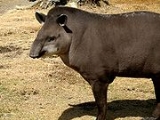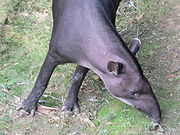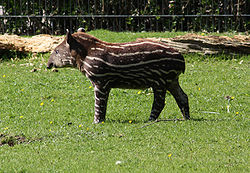
Brazilian Tapir
Encyclopedia
The South American Tapir (Tapirus terrestris), or Brazilian Tapir (from the Tupi tapi'ira) or Lowland Tapir or (in Portuguese) Anta, is one of four species in the tapir
family, along with the Mountain Tapir
, the Malayan Tapir
, and Baird's Tapir
. It is the second largest land mammal in South America
, after Baird's Tapir.
and River Basin
in South America, east of the Andes
. Its range stretches from Venezuela
, Colombia
, and Guiana
s in the north to Brazil
, Argentina
, and Paraguay
, in the south, to Bolivia
, Peru
, and Ecuador
in the West.
 Lowland Tapirs are excellent swimmers and divers but also move quickly on land, even over rugged, mountainous terrain. The species has a life span of approximately 25 to 30 years. In the wild, the main predators of the South American Tapir are crocodilians (only the Black Caiman
Lowland Tapirs are excellent swimmers and divers but also move quickly on land, even over rugged, mountainous terrain. The species has a life span of approximately 25 to 30 years. In the wild, the main predators of the South American Tapir are crocodilians (only the Black Caiman
and Orinoco Crocodile
, the latter of which is critically endangered, are large enough to take these tapirs, as the American Crocodile
only exists in South America in the far north) and large cats such as the Jaguar
and Cougar, which often attack the tapir at night when they leave the water and sleep on the riverbank. They are known to run to water when scared.
. Using its mobile snout, this tapir feeds on leaves, buds, shoots, and small branches that it tears from trees, fruit, grasses, and aquatic plants.
 They mate in April, May, or June, reaching sexual maturity in their third year of life. Females go through a gestation period of 13 months (390-395 days) and will typically have 1 offspring every two years. Newborn tapir are about 15 pounds and will be weaned in about 6 months.
They mate in April, May, or June, reaching sexual maturity in their third year of life. Females go through a gestation period of 13 months (390-395 days) and will typically have 1 offspring every two years. Newborn tapir are about 15 pounds and will be weaned in about 6 months.
 Dwindling numbers are due to poaching
Dwindling numbers are due to poaching
for meat and hide, as well as habitat destruction.
The South American Tapir is generally recognized as an endangered animal species, with the species being designated as endangered by the United States Fish and Wildlife Service
on June 2, 1970. The South American Tapir, however, had a significantly lower risk of extinction
than the other three tapir species.
Tapir
A Tapir is a large browsing mammal, similar in shape to a pig, with a short, prehensile snout. Tapirs inhabit jungle and forest regions of South America, Central America, and Southeast Asia. There are four species of Tapirs: the Brazilian Tapir, the Malayan Tapir, Baird's Tapir and the Mountain...
family, along with the Mountain Tapir
Mountain Tapir
The Mountain Tapir or Woolly Tapir is the smallest of the four species of tapir and is the only one to live outside of tropical rainforests in the wild...
, the Malayan Tapir
Malayan Tapir
The Malayan Tapir , also called the Asian Tapir, is the largest of the four species of tapir and the only one native to Asia. The scientific name refers to the East Indies, the species' natural habitat...
, and Baird's Tapir
Baird's Tapir
Baird’s Tapir is a species of tapir that is native to Central America and northern South America. It is one of three Latin American species of tapir.-Names:...
. It is the second largest land mammal in South America
South America
South America is a continent situated in the Western Hemisphere, mostly in the Southern Hemisphere, with a relatively small portion in the Northern Hemisphere. The continent is also considered a subcontinent of the Americas. It is bordered on the west by the Pacific Ocean and on the north and east...
, after Baird's Tapir.
Appearance
It is dark brown in color, paler in the face, and has a low, erect crest running from the crown down the back of the neck. The round, dark ears have distinctive white edges. The South American Tapir can attain a body length of 1.8 to 2.5 m (5.9 to 8.2 ft) with a 5 to 10 cm (2 to 3.9 in) short stubby tail and 225 kg (496 lb) in weight. Adult weight has been reported from 150 to 320 kg (330.7 to 705.5 lb). It stands somewhere between 77 to 108 cm (2.5 to 3.5 ft) at the shoulder.Range
The South American Tapir can be found near water in the Amazon RainforestAmazon Rainforest
The Amazon Rainforest , also known in English as Amazonia or the Amazon Jungle, is a moist broadleaf forest that covers most of the Amazon Basin of South America...
and River Basin
Amazon Basin
The Amazon Basin is the part of South America drained by the Amazon River and its tributaries that drains an area of about , or roughly 40 percent of South America. The basin is located in the countries of Bolivia, Brazil, Colombia, Ecuador, Guyana, Peru, and Venezuela...
in South America, east of the Andes
Andes
The Andes is the world's longest continental mountain range. It is a continual range of highlands along the western coast of South America. This range is about long, about to wide , and of an average height of about .Along its length, the Andes is split into several ranges, which are separated...
. Its range stretches from Venezuela
Venezuela
Venezuela , officially called the Bolivarian Republic of Venezuela , is a tropical country on the northern coast of South America. It borders Colombia to the west, Guyana to the east, and Brazil to the south...
, Colombia
Colombia
Colombia, officially the Republic of Colombia , is a unitary constitutional republic comprising thirty-two departments. The country is located in northwestern South America, bordered to the east by Venezuela and Brazil; to the south by Ecuador and Peru; to the north by the Caribbean Sea; to the...
, and Guiana
The Guianas
The Guyanas or the Guianas refers to a region in north-eastern South America which includes the following three territories:* French Guiana, an overseas department of France;...
s in the north to Brazil
Brazil
Brazil , officially the Federative Republic of Brazil , is the largest country in South America. It is the world's fifth largest country, both by geographical area and by population with over 192 million people...
, Argentina
Argentina
Argentina , officially the Argentine Republic , is the second largest country in South America by land area, after Brazil. It is constituted as a federation of 23 provinces and an autonomous city, Buenos Aires...
, and Paraguay
Paraguay
Paraguay , officially the Republic of Paraguay , is a landlocked country in South America. It is bordered by Argentina to the south and southwest, Brazil to the east and northeast, and Bolivia to the northwest. Paraguay lies on both banks of the Paraguay River, which runs through the center of the...
, in the south, to Bolivia
Bolivia
Bolivia officially known as Plurinational State of Bolivia , is a landlocked country in central South America. It is the poorest country in South America...
, Peru
Peru
Peru , officially the Republic of Peru , is a country in western South America. It is bordered on the north by Ecuador and Colombia, on the east by Brazil, on the southeast by Bolivia, on the south by Chile, and on the west by the Pacific Ocean....
, and Ecuador
Ecuador
Ecuador , officially the Republic of Ecuador is a representative democratic republic in South America, bordered by Colombia on the north, Peru on the east and south, and by the Pacific Ocean to the west. It is one of only two countries in South America, along with Chile, that do not have a border...
in the West.
Behavior

Black Caiman
The black caiman is a crocodilian. It is a carnivorous reptile that lives along slow-moving rivers and lakes, in the seasonally flooded savannas of the Amazon basin, and in other freshwater habitats in South America. Once common, it was hunted to near extinction primarily for its commercially...
and Orinoco Crocodile
Orinoco Crocodile
The Orinoco crocodile, Crocodylus intermedius, is a critically endangered crocodile found in freshwater in northern South America, in particular the Orinoco River. Typical measurements for adults range from 3 to 4.8 m . Typical weight for mature females is 200 kg and 380 kg for males...
, the latter of which is critically endangered, are large enough to take these tapirs, as the American Crocodile
American Crocodile
The American crocodile is a species of crocodilian found in the Neotropics. It is the most widespread of the four extant species of crocodiles from the Americas. Populations occur from the Atlantic and Pacific coasts of southern Mexico to South America as far as Peru and Venezuela. It also lives...
only exists in South America in the far north) and large cats such as the Jaguar
Jaguar
The jaguar is a big cat, a feline in the Panthera genus, and is the only Panthera species found in the Americas. The jaguar is the third-largest feline after the tiger and the lion, and the largest in the Western Hemisphere. The jaguar's present range extends from Southern United States and Mexico...
and Cougar, which often attack the tapir at night when they leave the water and sleep on the riverbank. They are known to run to water when scared.
Diet
It is an herbivoreHerbivore
Herbivores are organisms that are anatomically and physiologically adapted to eat plant-based foods. Herbivory is a form of consumption in which an organism principally eats autotrophs such as plants, algae and photosynthesizing bacteria. More generally, organisms that feed on autotrophs in...
. Using its mobile snout, this tapir feeds on leaves, buds, shoots, and small branches that it tears from trees, fruit, grasses, and aquatic plants.
Mating

Endangered status

Poaching
Poaching is the illegal taking of wild plants or animals contrary to local and international conservation and wildlife management laws. Violations of hunting laws and regulations are normally punishable by law and, collectively, such violations are known as poaching.It may be illegal and in...
for meat and hide, as well as habitat destruction.
The South American Tapir is generally recognized as an endangered animal species, with the species being designated as endangered by the United States Fish and Wildlife Service
United States Fish and Wildlife Service
The United States Fish and Wildlife Service is a federal government agency within the United States Department of the Interior dedicated to the management of fish, wildlife, and natural habitats...
on June 2, 1970. The South American Tapir, however, had a significantly lower risk of extinction
Extinction
In biology and ecology, extinction is the end of an organism or of a group of organisms , normally a species. The moment of extinction is generally considered to be the death of the last individual of the species, although the capacity to breed and recover may have been lost before this point...
than the other three tapir species.
External links
- ARKive - images and movies of the lowland tapir (Tapirus terrestris)
- Tapir Specialist Group - Lowland Tapir

